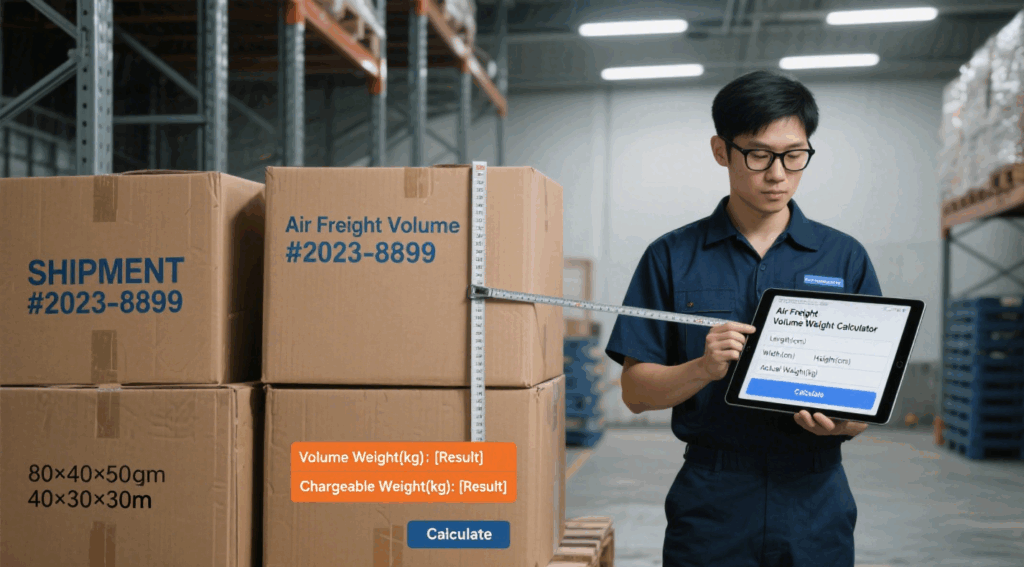When shipping goods by air, carriers do not only charge by actual weight — they also consider the space a shipment occupies. This is where an air freight volume weight calculator becomes essential. It helps determine the chargeable weight, ensuring accurate cost estimates and preventing unexpected freight bills. Understanding how to calculate volumetric weight is crucial for exporters, importers, and logistics managers.
1. What is an Air Freight Volume Weight Calculator?
An air freight volume weight calculator is a tool used to determine the volumetric weight of cargo based on its dimensions. Since large, lightweight items take up valuable aircraft space, airlines apply a formula to ensure fair pricing for both heavy and bulky shipments. The higher value between the actual gross weight and volumetric weight becomes the chargeable weight.
Key Points:
- Ensures accurate cost calculation
- Prevents underestimating freight expenses
- Helps in packaging optimization
2. How Volume Weight Differs from Actual Weight
- Actual weight: The physical weight of the shipment measured on a scale.
- Volume weight: Calculated from length × width × height, then adjusted with a conversion factor.
- The chargeable weight is whichever is greater between the two.
📍For example, a box of foam cushions may weigh 15 kg physically but occupy the equivalent space of a 50 kg shipment in the aircraft — you’ll be charged for 50 kg.
3. Formula for Air Freight Volume Weight
The standard IATA (International Air Transport Association) formula for calculating volumetric weight is:
Volumetric Weight (kg) = (Length (cm) × Width (cm) × Height (cm)) / 6000
Volumetric Weight (lbs) = (Length (in) × Width (in) × Height (in)) / 366
📍Example:
- Box size: 120 cm × 80 cm × 60 cm
- Volumetric weight: (120 × 80 × 60) ÷ 6000 = 96 kg
If actual weight is 75 kg, chargeable weight = 96 kg.

4. Why You Should Use an Air Freight Volume Weight Calculator
- Accurate Cost Estimation – Prevents budget surprises.
- Better Packaging Decisions – Optimize box sizes to reduce volume.
- Improved Freight Negotiation – Present accurate data to forwarders.
- Faster Quoting – Speeds up the booking process.
5. Step-by-Step Guide to Using the Calculator
- Measure dimensions in centimeters or inches.
- Multiply length × width × height.
- Divide by the standard divisor (6000 for cm, 366 for in).
- Compare with actual weight and choose the higher as chargeable weight.
- Apply carrier rates to estimate cost.
Need help calculating your shipment’s volumetric weight and getting the best air freight rates? Contact us today for an accurate cost estimate tailored to your cargo dimensions and destination.
6. Table: Common Air Freight Conversion Factors
| Unit of Measure | Formula | Divisor |
|---|---|---|
| cm to kg | L × W × H ÷ 6000 | 6000 |
| in to lbs | L × W × H ÷ 366 | 366 |
| m³ to kg | m³ × 167 | 167 |
7. Tips to Reduce Volumetric Weight Costs
- Use custom-fit packaging to minimize unused space.
- Disassemble items before packing.
- Switch to lighter materials for packaging.
- Consult your freight forwarder for consolidation options.
8.Conclusion
An air freight volume weight calculator is a vital tool for shippers to avoid unexpected charges and plan logistics budgets effectively. By understanding how volumetric weight works and applying the correct formulas, businesses can make smarter packaging choices, negotiate better rates, and ensure transparent shipping costs. Whether you ship lightweight goods or heavy machinery, using this calculation method ensures you pay the right price for the space your cargo occupies in an aircraft.
Request a Quote
Need a tailored solution for your shipping from China?
Let TJ China Freight Forwarder assist you with reliable, cost-effective service.
FAQ:
Q1.Is volumetric weight always higher than actual weight?
No. For dense items, actual weight is usually higher, and that becomes the chargeable weight.
Q2.Can different airlines have different divisors?
Yes. While 6000 is standard, some carriers use 5000, which increases the volumetric weight.
Q3.Does volumetric weight apply to sea freight?
Yes, but sea freight uses a different conversion, typically based on cubic meters.
Q4.How can I reduce volumetric weight for bulky items?
Repack into smaller boxes, compress soft items, or use vacuum-sealing.
Q5.Is an online calculator accurate?
Yes, if you input correct dimensions and the correct divisor for your carrier.
